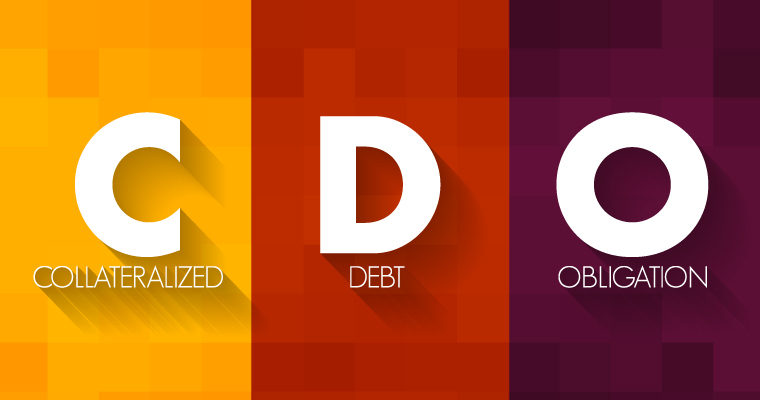What is Collateralized Debt Obligations (CDOs) and How Does it Work?

Investors can buy collateralized debt obligations or CDOs and depend on the assets within them to use as collateral if the original borrowers fail to pay the dues. Investors in CDOs receive regular payments of interest and principal, which are generated by the performance of the underlying pool of debt instruments.
This article will help you understand how CDOs work and their pros and cons in detail. Let’s dive in.
What is a Collateralized Debt Obligation (CDO)?
Collateralized debt obligations (CDOs) are securities that are created by combining and tranching (slicing) various types of debt instruments, such as corporate bonds, mortgage-backed securities, and other types of debt.
They are structured financial products that are created by investment banks and sold to investors. CDOs are typically rated by credit rating agencies, which evaluate the creditworthiness of the underlying pool of debt instruments and assign a rating to the CDO based on that assessment.
CDOs can be a useful way for investors to diversify their portfolios and manage risk, as they provide exposure to a diverse pool of debt instruments.
How Does a Collateralized Debt Obligation Work?
Collateralized debt obligations are synthetic investment products that retail banks, investment banks, commercial banks and other financial institutions create by bundling different loans. These bundles are then sold in the secondary market. The complexity of these instruments requires advanced computer modelling and a highly knowledgeable team of quantitative analysts to package the debts and assign value to the packages that form a collateralized debt obligation.
Once the package is created, a group of professionals is responsible for introducing the security to the market. The CDO manager determines which debt will serve as collateral. This can be any debt among student loans, mortgages, auto loans, corporate debt, or credit cards. Once the CDO manager makes their decision about the debt to be grouped, investment banks then work on the structure of the security.
As the next step, CDOs get credit ratings. There are specialised rating agencies that assign these ratings.
Once the bundling, structuring, and rating are done, the CDO is sold to institutional investors in highly valued lots. They cannot be sold to retail investors. The buyers of synthetic CDOs include insurance companies, investment managers, pension funds, hedge funds, etc.
Example of a Collateralized Debt Obligation
A collateralized debt obligation example can be mortgage-backed securities. The portfolio of these CDOs includes debt assets like credit card debts, corporate debts, auto loans and other similar loans. The value of these securities can be attributed to the security of getting repaid and falling under the category of collateralized debt obligations.
Also Read
What are the Types of CDOs?
CDOs can include a multitude of debt types, including corporate bonds, student loans, business loans, mortgages, credit card debts or any other credit products.
The different types of CDOs are mentioned below:
1. Collateralized Bond obligations (CBOs)
Leveraged fixed income securities are the debt assets behind these CDOs
2. Collateralized Loan Obligations (CLOs)
Leveraged bank loans secure these CDOs
3. Structured Finance CDOs (SFCDOs)
Structured funds are the debt assets behind these CDOs
4. Collateralized Synthetic Obligations (CSOs)
Credit derivatives secure these CDOs
5. Synthetic CDOs
Credit default swaps become the collateral in synthetic CDOs
How are CDOs Structured?
Collateralized debt obligations have a complex structure. The way CDOs sell securities to investors is similar to how corporations sell bonds. In the CDO structure, the names of the tranches are indicative of their risk profiles.
Senior debt, mezzanine debt, and junior debt are some names of tranches. The actual CDO structure is different for different products. A credit rating agency grades every security and its repayment schedule. Highly rated securities with AAA scores pose a lower risk and offer lower returns on investment. Lower-rated bonds, on the other hand, offer higher returns on investment at a higher risk.
Pros and Cons of CDOs
Here are some of the advantages of CDOs:
1. Diversification
CDOs provide investors with exposure to a diverse pool of debt instruments, which can help to diversify their portfolios and reduce the overall level of risk.
2. Credit Enhancement
CDOs may offer credit enhancement to the underlying pool of debt instruments, which can improve the creditworthiness of the securities and make them more attractive to investors.
3. Income Potential
CDOs can generate regular payments of interest and principal for investors, which can provide a steady stream of income.
4. Liquidity
CDOs are widely traded on the secondary market, which can provide investors with the ability to easily buy and sell their holdings.
However, there are a few notable drawbacks of CDOs too. These include:
1. Complexity
The complexity of CDOs can make it challenging for investors to properly evaluate the risks and potential returns of CDOs.
2. Credit Risk
CDOs are backed by a pool of debt instruments. If the underlying securities default or experience credit downgrades, it can negatively impact the value of the CDO.
3. Interest Rate Risk
CDOs are typically fixed income securities, which means that they are sensitive to changes in interest rates. If interest rates rise, it can lead to a decline in the value of CDOs.
4. Lack of Transparency
CDOs can be difficult for investors to evaluate due to the complexity of the underlying pool of debt instruments and the lack of transparency in the market for these securities. This can make it challenging for investors to accurately assess the risks and potential returns of CDOs.
Final Word
CDOs serve multiple purposes such as helping the financial institution to move debt and get liquidity. Investors also benefit from cash flow facilitated by coupon payments and hope the returns on CDOs outperform standard fixed income portfolios.
Only institutional investors can make CDO payments. If retail investors wish to benefit from CDOs, they must invest in mutual funds and ETFs with CDOs in their portfolios.
FAQs
Ans. CDOs are attractive investment options for institutional investors because they have a balanced risk profile and often offer better returns than other financial instruments with a similar maturity.
Ans. CDOs are available only to institutional investors. As a retail investor, you can invest in ETFs and mutual funds that invest in CDOs.
Ans. CDOs are created by investment banks, which package together a diverse pool of debt instruments and sell them to investors.
Ans. CDOs are typically rated by credit rating agencies, which evaluate the creditworthiness of the underlying pool of debt instruments and assign a rating to the CDO based on that assessment.

Customer’s Feedback
No comments found.10 Best Bank for Savings Account in India [Highest Interest Rate 2023]
Savings account is a type of financial instrument offered by several banks. It lets you safely depo... Read More »What is Issuer Identification Number (IIN)- Working and Importance
What is an Issuer Identification Number (IIN)? Banks and financial institutions assign a distinc... Read More »What is a Vostro Account – Meaning, Working and Difference
What is a Vostro Account? A Vostro account is a bank account held by a domestic bank on behalf o... Read More »What is a Solvency Certificate? – Format, Documents Required & How to Apply Online?
What is a Solvency Certificate? A solvency certificate is a legal document furnishing the detail... Read More »What is Merchant Banking – Services, Features, Functions and Example
What is Merchant Banking? Merchant banking is a set of select banking and financial services off... Read More »Automated Clearing House: Objectives, Types and Process
Automated Clearing House is an electronic fund transfer network that manages automatic and direct... Read More »How to Redeem Credit Card Reward Points ?
Credit Card Reward points are types of incentives that customers receive when they use a credit car... Read More »What is Electronic Clearing Service (ECS) in Banking and How does it Work?
What is Electronic Clearing Service (ECS)? Electronic Clearing Service (ECS) is a method of elec... Read More »What are Credit Card Validators and How to Use them?
What is a Credit Card Validator? A credit card validator is a tool that checks the validity of a... Read More »What is Cash Management and How Does it Work?
Managing available capital can make sure that a small business stays afloat. Cash management is an ... Read More »What are Prepaid Expenses? – Definition, Examples, and Journal Entry
Prepaid expenses represent payments made in advance for products or services expected to be incurre... Read More »Increase Credit Card Limit – Important Tips and How to Do It?
The credit card limit is the maximum amount of money you can spend using your credit card. Your cre... Read More »Top 10 Chit Fund Schemes in India in 2023
Chit funds are one of the most popular return-generating saving schemes in India. It is a financial... Read More »10 Best Gold ETFs in India to Invest in April 2023
Gold ETFs or Gold Exchange Traded Funds are passively managed funds that track the price of physica... Read More »10 Best Demat Accounts in India for Beginners in 2023
Creation of Demat accounts revolutionised the way trades were conducted at the stock exchanges. It... Read More »20 Best Index Funds to Invest in India in April 2023
What is an Index Fund? An index fund is a type of mutual fund or exchange-traded fund (ETF) that... Read More »Best Arbitrage Mutual Funds to Invest in India in April 2023
Arbitrage funds are hybrid mutual fund schemes that aim to make low-risk profits by buying and sell... Read More »10 Best SIP Plans in India to Invest in April 2023
What is SIP? SIP or Systematic Investment Plan is a method of investing a fixed amount in ... Read More »10 Best Corporate Bond Funds in India to Invest in April 2023
Corporate bond funds are debt funds that invest at least 80% of the investment corpus in companies ... Read More »10 Best Bank for Savings Account in India [Highest Interest Rate 2023]
Savings account is a type of financial instrument offered by several banks. It lets you safely depo... Read More »





















